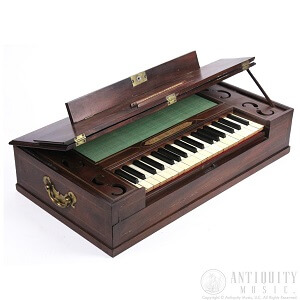Glasschord
 Glasschord. 37 glass bars tuned chromatically. Compass: three octaves, c' to c''''. Case of mahogany. Nameboard is inlaid with satinwood and is pierced with two fretwork panels on either side of a central medallion that likely once bore a maker's inscription. Hammer action. Hammers are covered with soft cloth.
Glasschord. 37 glass bars tuned chromatically. Compass: three octaves, c' to c''''. Case of mahogany. Nameboard is inlaid with satinwood and is pierced with two fretwork panels on either side of a central medallion that likely once bore a maker's inscription. Hammer action. Hammers are covered with soft cloth.
An instrument very similar to this example made by Chappell & Co., London, is in the collection of the Victoria and Albert Museum in London. The glasschord has long been connected with Benjamin Franklin, whose role in the development of the glass harmonica is widely known. Franklin may have provided the English name for this instrument. (The trade name, "pianino," used by Chappell & Co., is ambiguous at best.) Thomas Jefferson, in a letter of 6 July 1785, from Paris, describes Franklin's interest in the instrument: "The Doctr. Franklin carries with him a little instrument. It is the sticcado, with glass bars, instead of wooden ones, and with keys applied to it."